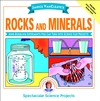What are Rocks?
Rocks are a mixture of different kinds of minerals.
What are Minerals?
The following definitions on what constitutes a mineral information is from B and L Fine Minerals.
The definitions are from different were taken from several different sources and are arranged by year.
“A mineral is an element or chemical compound that is normally crystalline and that has been formed as a result of geological processes” (Nickel, E. H., 1995).
“Minerals are naturally-occurring inorganic substances with a definite and predictable chemical composition and physical properties.” (O’ Donoghue, 1990).
“A mineral is a naturally occurring homogeneous solid, inorganically formed, with a definite chemical composition and an ordered atomic arrangement” (Mason, et al, 1968).
“These… minerals …can be distinguished from one another by individual characteristics that arise directly from the kinds of atoms they contain and the arrangements these atoms make inside them” (Sinkankas, 1966).
“A mineral is a body produced by the processes of inorganic nature, having usually a definite chemical composition and, if formed under favorable conditions, a certain characteristic atomic structure which is expressed in its crystalline form and other physical properties” (Dana & Ford, 1932).
“Every distinct chemical compound occurring in inorganic nature, having a definite molecular structure or system of crystallization and well-defined physical properties, constitutes a mineral species” (Brush & Penfield, 1898).
—————————————————————-
Janice VanCleave’s Rocks and Minerals is a book with 20 fun and simple experiments that allow you to discover the answers to questions about rocks and minerals, such as:
Can rock melt?
What are fossils?
How do stalactites and stalagmites form?
The book also contains dozens of ideas for developing your own science fair projects about rocks and minerals.
See how sedimentary rock is formed using two pillows, a yardstick, and some masking tape. Make models of rocks and minerals with gumdrops, toothpicks, and plastic bags. Learn what carbonate minerals are and how to identify them using a glass jar, some vinegar, and an egg. All experiments use inexpensive household materials and involve a minimum of preparation and clean up.
 |
Janice VanCleave’s Rock and Minerals: Mind-Boggling Experiments You Can Turn Into Science Fair Projects |
